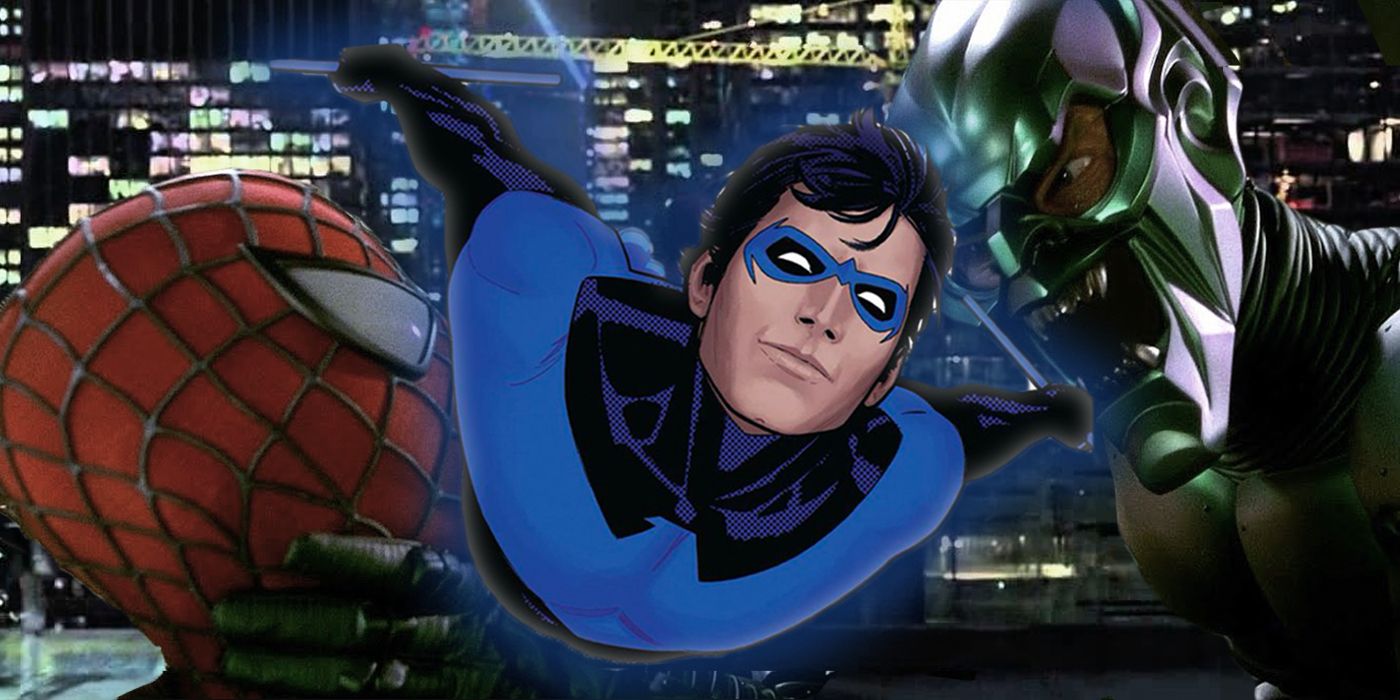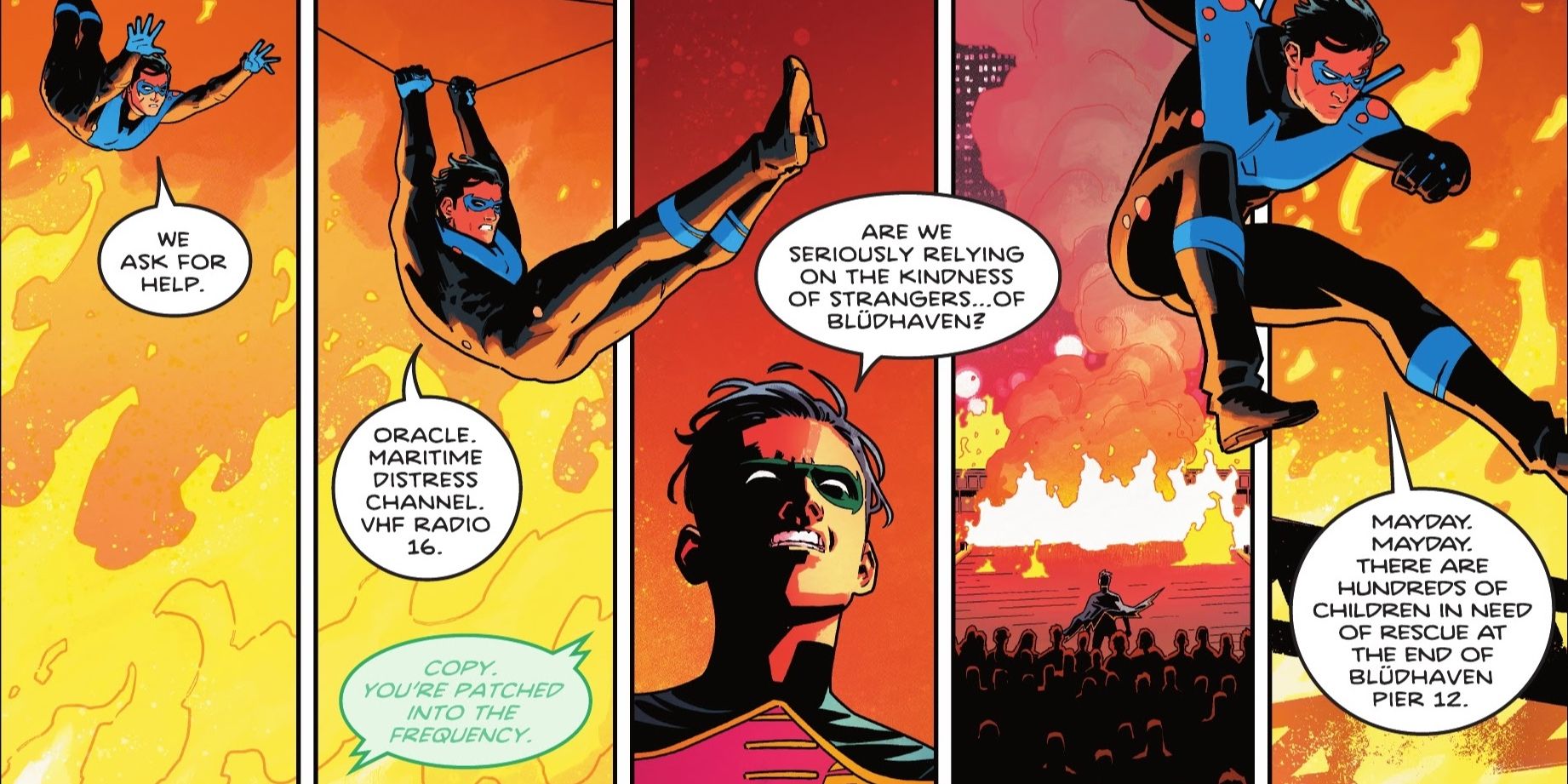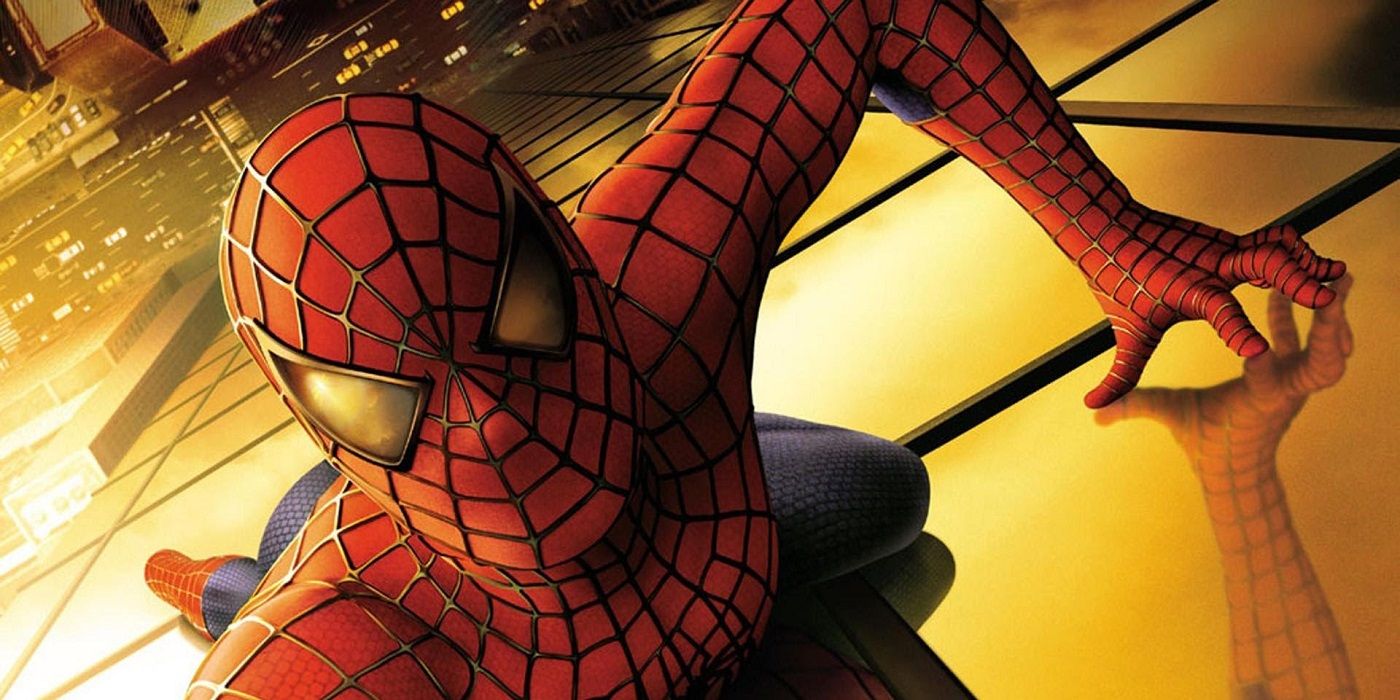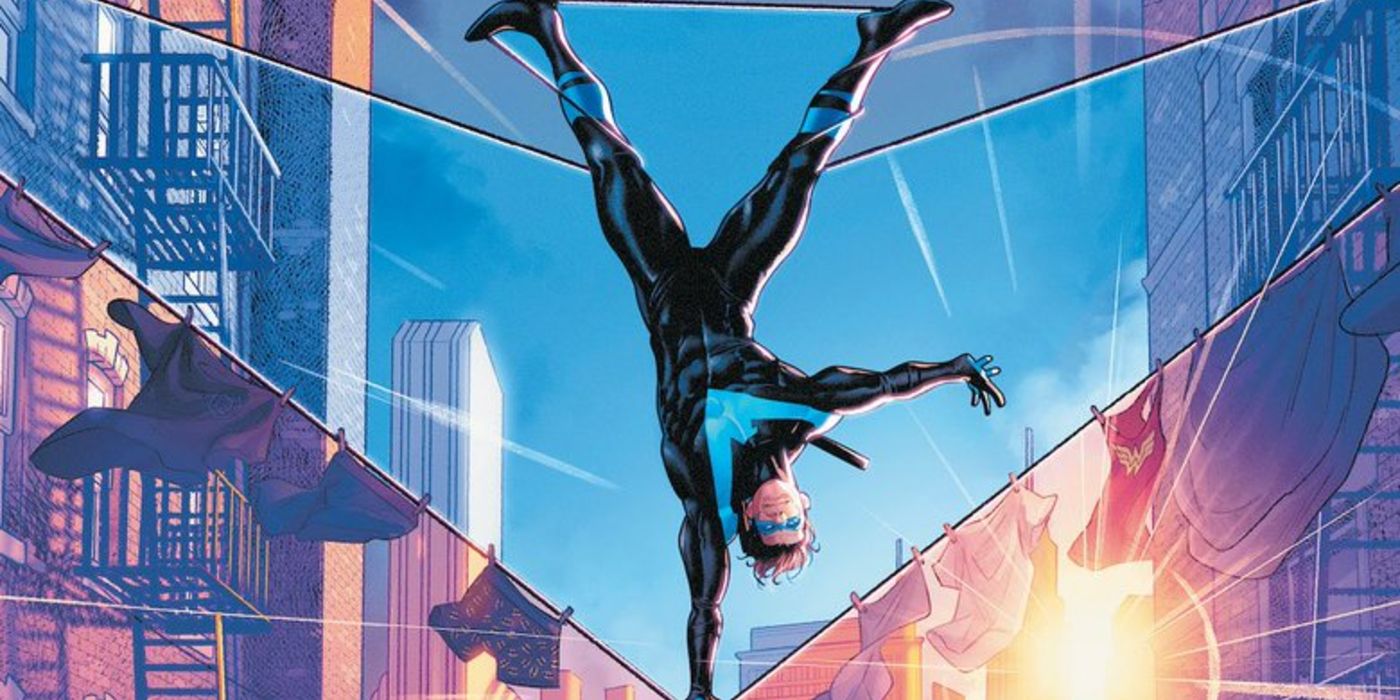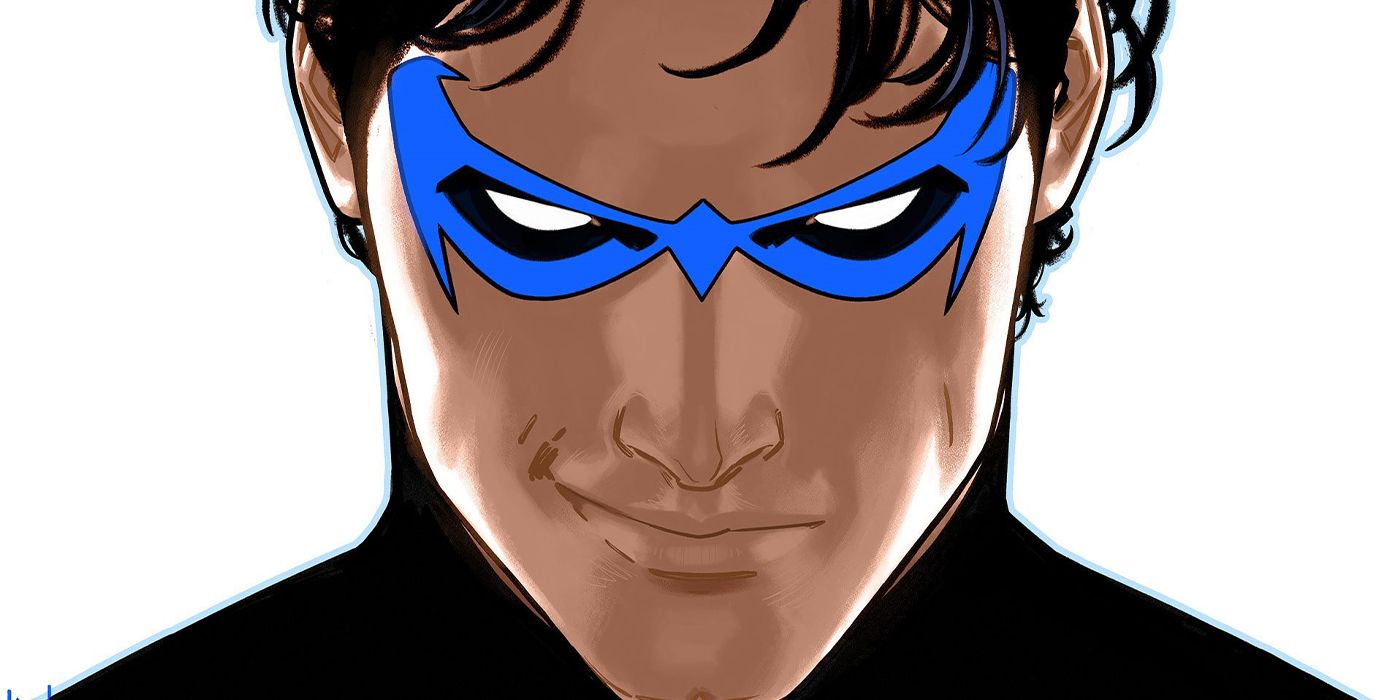Warning: spoilers for Nightwing #81 by Tom Taylor, Bruno Redondo, Adriano Lucas, and Wes Abbott are ahead.
Nightwing (Dick Grayson) doesn't need superpowers to prove that he is one of DC Comics' most selflessly heroic characters, perhaps to a fault. Working and living in Blüdhaven is seldom ever easy due to the city's staggering inequality, but Dick Grayson still believes that a better future can be forged nonetheless. As a hero who often equates his own wellbeing to that of his city's, Nightwing's sense of hope is refreshing in its sincerity.
The current Nightwing run, written by Tom Taylor with art by Bruno Redondo, colors by Adriano Lucas, and letters by Wes Abbott, brings out the best attributes of his character whilst still lending an air of believability to Blüdhaven's social problems. At the climax of Nightwing #81, Dick faced an insurmountable problem: Robin, his dog Haley, and hundreds of children were stranded on a pier after a homeless encampment was set on fire by the villain, Heartless. When Heartless blew up their only way back to land, Nightwing had to improvise a way to save everyone from the flames. Calling in a mayday to surrounding boats in the area, the children were saved by a group of citizens answering the call before Nightwing finally blacked out.
This scene strikes a rare balance between showcasing Nightwing's heroism while still providing a realistic, if optimistic, vision of his city. Sure, Blüdhaven may have a bad reputation, but its soul is still good. Dick's belief in this has remained a recurring theme in Taylor, Redondo, Lucas, and Abbott's run thus far. Instead of crafting a vision of Blüdhaven where Nightwing is the only heroic figure around, writer Tom Taylor smartly shows that heroism doesn't always come in a spandex suit. While the homeless children are civilians in need of assistance, it is ordinary people who ultimately save the day, flipping readers' expectations entirely.
While this is a small distinction, it is important because of its rarity in superhero media. The scale of the crisis is reminiscent of similarly grandiose showdowns in Spider-Man films. Spider-Man has long been thought of as a "hero of the people," but in many movie adaptations, Peter Parker's importance as a hero has been emphasized over the agency of ordinary people trying to make their city a better place. Like Nightwing, Spider-Man has the power to lead by example and encourage citizens to be the best versions of themselves. But in a dynamic where he singularly saves everyone against impossible odds, it widens the gap between him and the city he protects. By democratizing heroism and heroic acts in Nightwing #81, writer Tom Taylor steers clear of the corniness that surrounds many of the climactic moments in Spider-Man films.
Civilians Make Spider-Man A Hero Rather Than Becoming Heroes Themselves.
On the whole, the Spider-Man films have been concerned with showing how one person can make a difference in their city, reflected in how Peter Parker is always the one who saves the day. Though the singularity of Spider-Man's character has made him immensely popular worldwide, it has also ushered in a level of corniness that undercuts some of the emotional beats in his films. And while filmmakers have tried to capture this essence through New Yorkers coming to Spider-Man's aid in Spider-Man and The Amazing Spider-Man, their involvement stops short of actually preventing catastrophe. From throwing random objects at Green Goblin and shouting, "You mess with one of us, you mess with all of us" to lining up cranes to help Spider-Man get across town, civilians in these films set up a spectacle for Spider-Man to save the day. Their efforts ultimately aid the construction of Spider-Man's heroic image in the film, because they help convince the audience that Peter Parker is a hero they should root for.
And while this approach is understandable and often enjoyable to watch nonetheless, Nightwing #81 digs at something deeper. The current Nightwing run understands Dick Grayson's role as an individual agent of good in Blüdhaven, operating with the belief that he sometimes will have to call on the help of citizens to assist where he physically cannot. His physical limitations as a hero help keep him believable, not only in the types of feats he can pull off, but also in his relationship with the public. Yes, the public needs Nightwing, but Nightwing also needs the public, and this is what this issue showcases so well.
Nightwing's Story Benefits From His Confidence As A Hero.
This issue shows that heroism can be shared, which goes against the approach of the Spider-Man films. The boats answering Nightwing's mayday call offer something the hero doesn't have in that moment: the ability to save the children on the pier. This distinction does something rare because it sets aside heroic moments for ordinary people who act on their own accord. Though Nightwing is the protagonist of the series, his individual importance as the hero does not eclipse that of Blüdhaven's. There is room for both Dick Grayson and the citizens of Blüdhaven to be heroic in their own ways without relying entirely on the other's actions. In some ways, this parallels the ferry scene in The Dark Knight, when two boats full of inmates and civilians save themselves without Batman's help. Though both ships were rigged with explosives and the detonator to blow the other one up, neither party needed Batman because the goodness of their character prevented them from playing into the Joker's plan to begin with.
This approach highlights one of the best parts about Dick Grayson's character: his lack of ego. He isn't driven by a need to prove himself to anyone, not even to readers, and writer Tom Taylor lets this understanding of the character drive the events of story in Nightwing #81. Fans don't need to see Nightwing save all of those kids on the pier to believe in him as a hero. His heroic qualities aren't something that must be "sold" to the audience through corny scenes where ordinary people go out of the way to help him save the day. While Nightwing is indisputably a superhero story, it remains comfortable in showcasing that an alternate vision of the heroic can proliferate in Blüdhaven. The public's actions on the pier prove that Blüdhaven isn't a lost cause not because it has Nightwing, but because it can still save itself when he physically can't. This is a refreshing approach because it shifts emphasis away from the hero at the moment when readers expect to see it most.
It is difficult for many to imagine Nightwing or Spider-Man outside of an urban context, making their actions and relationship to the public all the more important. They are a part of their communities just as much as their communities are a part of them. While Spider-Man films have an enjoyable sentimentality to them, their commitment to convincing the audience that only Spider-Man can save the day often comes off as trite. The approach that the creative team on Nightwing has taken provides a powerful counterpoint to the vision of Sam Raimi's Spider-Man trilogy and the later Amazing Spider-Man films.
Though Blüdhaven is far from perfect, it still has redeeming qualities that Nightwing believes in. This issue beautifully illustrates the merits of its hero's optimism while also challenging a foundational dynamic between superheroes and ordinary citizens. The boat rescue at the end of the issue proves why superheroes do not need to have a monopoly over heroic moments in comics and beyond. It can be equally satisfying to see regular people, against all cynical odds, come to help others at their darkest moment.

